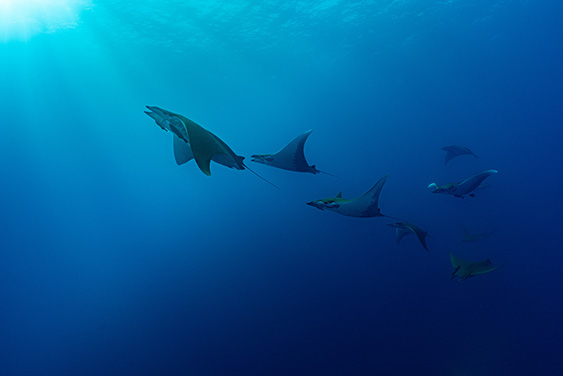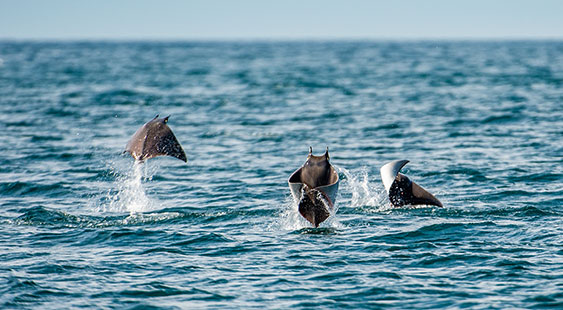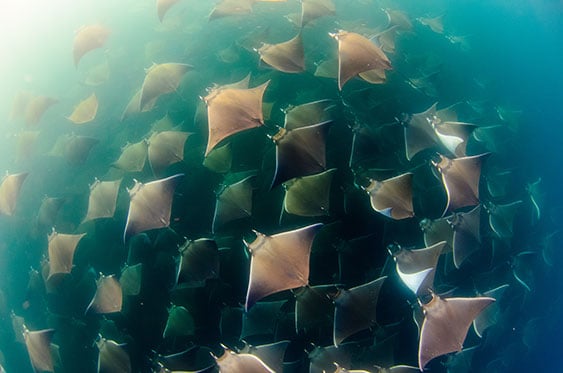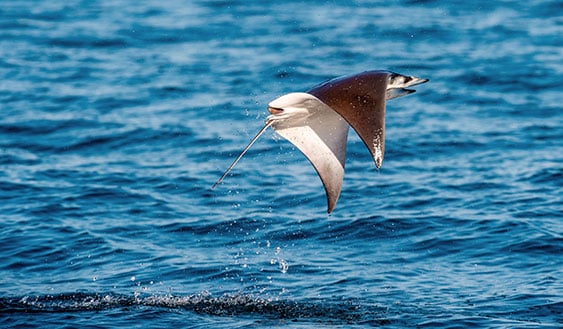Mobula Rays, also known as devil rays, are a unique species that live in Cabo San Lucas

It's a bird, it's a plane, it's a Mobula or Devil Ray! These incredible creatures are truly something to see. Mobula rays soaring through the air, with a wingspan of up to 17 feet, these cool creatures redefine our traditional idea of what a fish can do. As the Mobula rays love to congregate in Cabo, we are proud to share a little bit about them with you, in the hopes you will come visit them for yourself during your next Mexican vacation.
Mobula rays are similar to stingrays, but not the same.
Unlike stingrays, the Mobula does not have a stinger, making it a lot less devilish than its nickname implies. Additionally, the Mobula has a large crest-like shoulder marking that its stinger counterpart does not boast.

They use two methods of transportation: flight and fins.
While the fact that these flying rays can jump two meters out of the surface of the water is likely their most remarkable feature, they are as good at swimming as they are jumping.
Their extremely long wingspan allows these rays to propel themselves forward at high speeds, empowering them to travel great distances and depths. For example, they can dive down nearly two km and swim at the surface at a rate of 13 mph.

Smarter – and friendlier – than your average fish.
Despite their size, Mobula rays are not considered dangerous and the species will only attack if provoked to defend themselves.
Otherwise, they are quite curious about the world of humans and seem to demonstrate a certain level of self-awareness and willingness to play.
These creatures are certainly sizable.

On average, the giant devil ray will measure about six to nine feet wide. However, some species of these splendid high-flyers can reach up to 17 feet, which is about the same size as three standard refrigerators.
A Mobula Ray can weigh a lot.
If that size comparison is not shocking enough, how do you feel about the fact these rays weigh about 1,600 kilograms? For comparison's sake, that is the same as a Jeep Cherokee or John Deere compact tractor.
For Mobula Rays, three is not a crowd.
These marine animals like to swim in schools of, at least, a hundred or more of their closest friends. So a Mobula Ray is never lonely.

They like to host large dinner parties.
Devil rays are not food hogs. Alternatively, when they find an area rich with their favorite foods – plankton and other tiny fish – they share the wealth with their entire extended family, all of whom scoop up their microscopic prey with the lobes that hang from either side of their heads.

Where/when can I see Mobula rays in Cabo?
One of the key migration destinations of these larger-than-life swimmers is the shores and coast of Baja California. Visit Cabo in late April through to July and November through to January to see massive schools of these swimmers congregating along the peninsula.

Their high-flying feats don’t just include jumping.
When you see these devilish rays out of the water, they may be engaging in what can only be described as airborne acrobatics. Watch these rays twist, turn, flip, and flop atop the tropical Caribbean Sea.

Mobula mamas are in it for the long haul.
When a Devil Ray gets pregnant, it takes more than 12 months for her to bring a baby to full gestation, and she typically only gives birth to one to two pups every two to three years.

Our professional tour guides love the ocean – and all its animals – as much as you do, and we’re excited to show them off.
Visit us in Cabo San Lucas and take part in one of our snorkeling, diving, or sailing tours to see the Mobula rays for yourself. This is an unforgettable experience where you will enjoy every minute of the azure sea while witnessing these high-flying creatures.









